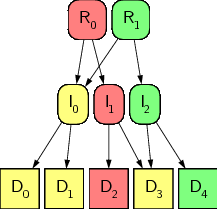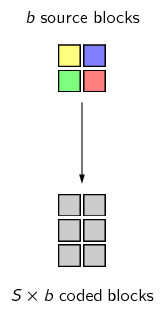2 / 18 -- Fault Tolerance for Mobile Devices
|  |
4 / 18 -- Constraints Imposed on the Storage Layer
- Scarce Resources
- (energy, storage, CPU)
- Short-lived and Unpredictable Encounters
- Lack of Trust Among Participants
5 / 18 -- Maximizing Storage Efficiency
- Single-Instance Storage
- Generic Lossless Compression
- Techniques Not Considered
6 / 18 -- Chopping Data Into Small Blocks
- Natural Solution: Fixed-Size Blocks
- Finding More Similarities Using Content-Based Chopping
7 / 18 -- Providing a Suitable Meta-Data Format
|  |
8 / 18 -- Providing Data Confidentiality, Integrity, and
Authenticity
- Enforcing Confidentiality
- Allowing For Integrity Checks
- Allowing For Authenticity Checks
9 / 18 -- Enforcing Backup Atomicity
- Comparison With Distributed and Mobile File Systems
- Using Write-Once Semantics
11 / 18 -- Our Storage Layer Implementation: libchop
- Key Components
- Strong Focus on Compression Techniques

13 / 18 -- Algorithmic Combinations
| Config. | Single Instance? | Chopping Algo. | Expected Block Size | Input Zipped? | Blocks Zipped? |
|---|---|---|---|---|---|
| A1 | no | --- | --- | yes | --- |
| A2 | yes | --- | --- | yes | --- |
| B1 | yes | Manber's | 1024 B | no | no |
| B2 | yes | Manber's | 1024 B | no | yes |
| B3 | yes | fixed-size | 1024 B | no | yes |
| C | yes | fixed-size | 1024 B | yes | no |
14 / 18 -- Storage Efficiency & Computational Cost Assessment
| Config. | Summary | Resulting Data Size | Throughput (MiB/s) | ||||
|---|---|---|---|---|---|---|---|
| C files | Ogg | mbox | C files | Ogg | mbox | ||
| A1 | (without single instance) | 26% | 100% | 55% | 21 | 15 | 18 |
| A2 | (with single instance) | 13% | 100% | 55% | 22 | 15 | 17 |
| B1 | Manber | 25% | 102% | 88% | 12 | 6 | 15 |
| B2 | Manber + zipped blocks | 11% | 103% | 58% | 7 | 5 | 10 |
| B3 | fixed-size + zipped blocks | 18% | 103% | 71% | 11 | 5 | 18 |
| C | fixed-size + zipped input | 13% | 102% | 57% | 22 | 5 | 21 |
15 / 18 -- Storage Efficiency & Computational Cost Assessment
- Single-Instance Storage
- Content-Defined Blocks
- (Manber)
- Lossless Compression
16 / 18 -- Conclusions
- Implementation of a Flexible Prototype
- Assessment of Compression Techniques
- Six Essential Storage Requirements
17 / 18 -- On-Going & Future Work
- Improved Energetic Cost Assessment
- Algorithmic Evaluation
- Design & Implementation

